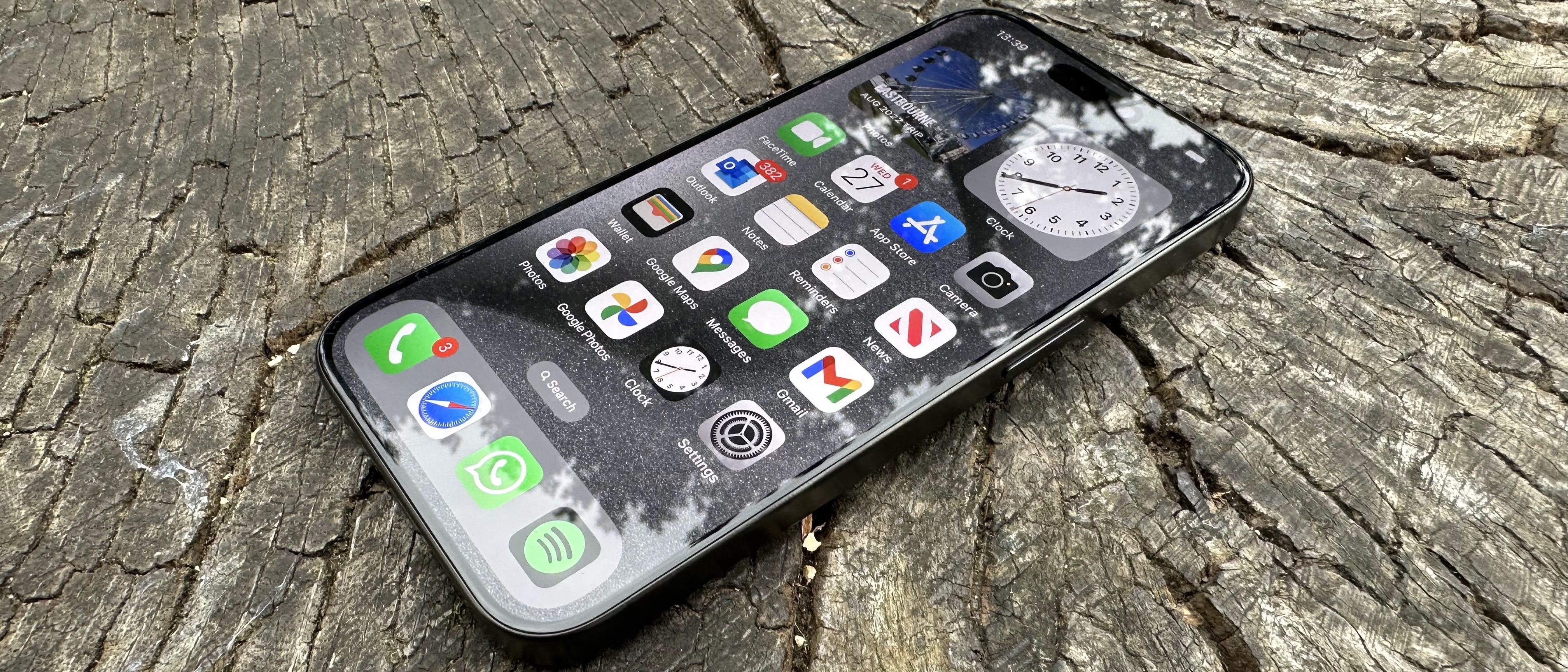iMore Verdict
The iPhone 15 Pro trims, tweaks, and tidies the top-end iPhone design into a streamlined handset that brings meaningful additions in the shape of USB-C charging and a programmable Action button. But its real power may only truly present itself once (and if) developers start taking advantage of its souped-up chipset.
Pros
- +
USB-C… finally!
- +
Useful Action button
- +
Excellent cameras
- +
Lighter build with slimmer bezels
- +
Impressive graphics abilities
Cons
- -
Titanium edges discolor at your touch
- -
No charging speed boosts
- -
5x zoom reserved for Pro Max model
- -
Slow USB-C cable in the box
You can always trust iMore.
For the first time in a long while, we can definitively say that, right out of the gate, the iPhone 15 Pro is the second-best iPhone Apple has ever made. That’s because, for the first time, the iPhone 15 Pro Max model (representing the top end of the range which is usually tied with the smaller Pro on all counts aside from subjective merits like the value of a larger screen) has a key feature that beats out the 15 Pro. The 15 Pro Max has a 5x optical camera zoom, the 15 Pro does not, packing 3x optical zoom instead.
That in itself may be all you need to know if you’re after the best of the best that Apple has to offer. But that’d see you ignoring a host of other small but meaningful updates to the phone that, when stacked up, make for a significantly improved phone over the iPhone 14 Pro, at a far more comfortable size (and price!) than the 15 Pro Max weighs in at.
So the iPhone 15 Pro is the second best iPhone out there — but it’s the one I’d recommend to most people. Read on for the reasons why.
- Looking for something bigger? Read our iPhone 15 Pro Max review
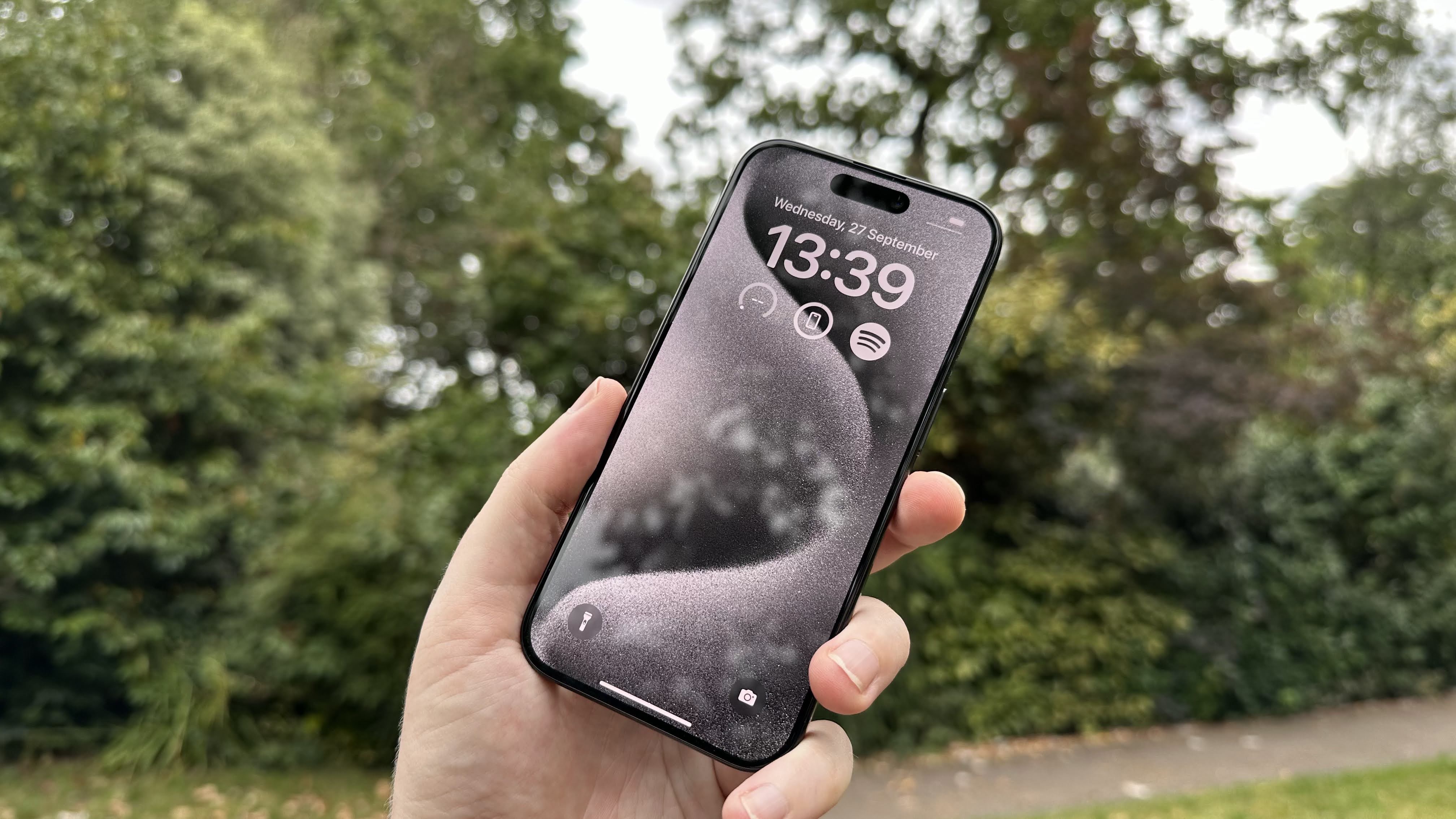
iPhone 15 Pro Price and Availability
The iPhone 15 Pro hit stores on September 22, with a starting price of $999 for the 128GB model. That’s the same price point that last year’s iPhone 14 Pro started at, which is a relief to see, though that 128GB entry storage is starting to feel the strain with those 48MP ProRAW shots and ProRes video capture capabilities.
For $1,199 you can boost up to the 256GB storage version, $1,299 gets you 512GB and the top-tier 1TB model costs $1,499.
As ever, they’re expensive devices but packed with premium features. And this year’s new additions to the iPhone mix make it even more welcome that prices have remained static year on year.
What’s new? At a glance…
In a nutshell, here’s what’s changed with the iPhone 15 Pro compared to last year’s iPhone 14 Pro phone.
iMore offers spot-on advice and guidance from our team of experts, with decades of Apple device experience to lean on. Learn more with iMore!
- Lighter, tougher titanium build
- Improved repairability
- Programmable Action button replaces the mute switch
- USB-C charging and data transfer
- iOS 17 out of the box
- A17 Pro chip (3nm, with up to 20% faster GPU and 10% faster CPU, plus an extra GPU core)
- 8GB memory
- Wi-Fi 6E
Specs: iPhone 15 Pro and iPhone 15 Pro Max compared
Here's a by-the-numbers look at how the specs of iPhone 15 Pro vs iPhone 15 Pro Max stack up this year:
| Specs | iPhone 15 Pro | iPhone 15 Pro Max |
| Display size | 6.1 inches | 6.7 inches |
| Material | Titanium, matte glass back | Titanium, matte glass back |
| Display type | OLED, ProMotion, Always-On | OLED, ProMotion, Always-On |
| Refresh rate | 120Hz | 120Hz |
| Action Button | Yes | Yes |
| Dynamic Island | Yes | Yes |
| Capacity | 128GB, 256GB, 512GB, 1TB | 256GB, 512GB, 1TB |
| Splash, water, dust resistance | IP68 | IP68 |
| Chip | A17 Pro chip, 6 core CPU, 6-core GPU, 16-core neural engine | A17 Pro chip, 6 core CPU, 6-core GPU, 16-core neural engine |
| Camera | 48MP triple-camera system + TrueDepth front camera with autofocus, ƒ/1.5 aperture | 48MP triple-camera system + TrueDepth front camera with autofocus, ƒ/1.5 aperture |
| Video | 4K video recording at 24 fps, 25 fps, 30 fps, or 60 fps | 4K video recording at 24 fps, 25 fps, 30 fps, or 60 fps, Action Mode |
| Zoom: | .5x, 1x, 2x, 3x optical zoom options | .5x, 1x, 2x, 5x optical zoom options |
| Face ID | Yes | Yes |
| Apple Pay | Yes | Yes |
| Safety | Emergency SOS via satellite, Crash Detection, Roadside Assistance via satellite | Emergency SOS via satellite, Crash Detection, Roadside Assistance via satellite |
| Location | GPS, GLONASS, Galileo, QZSS, and BeiDou | GPS, GLONASS, Galileo, QZSS, and BeiDou, Digital compass, WiFi, Cellular, iBeacon microlocation |
| Video calling | Yes | Yes |
| Audio calling | Yes | Yes |
| Siri | Yes | Yes |
| Power and battery | Video playback: up to 23 hours | Video playback: up to 29 hours |
| MagSafe | Yes | Yes |
| Fast charging | Yes | Yes |
| Sensors | Face ID, Barometer, High dynamic range gyro, High-G accelerometer, Proximity sensor, Dual ambient light sensors | Face ID, Barometer, Three-axis gyro, Accelerometer, Proximity sensor, Ambient light sensor |
| Operating system | iOS 17 | iOS 17 |
| SIM | eSIM | eSIM |
iPhone 15 Pro Design
TITANIUM! Tough, tough TITANIUM!
That’s what Apple is trumpeting the loudest when it comes to the iPhone 15 Pro design this year. There are a few other refinements to the external design of the iPhone 15 Pro, such as slightly curvier, tapered edges, but it’s the titanium construction that has the most impact in the hand. Stronger and lighter than the sharper-edged stainless steel iPhone 14 Pro, this year’s model knocks 19g off the weight for a 187g total. Though the handset is 0.4mm thicker than the 14 Pro, the iPhone 15 Pro feels more comfortable to hold thanks to that combination of contoured edges and lighter weight.
It’s the same alloy composite that NASA has used in its Mars Rover program, which should speak to its durability — but we’ve not actively been looking to smash our iPhone into the rocky desolation of a distant planet, so we’ll have to take Apple’s word for just how tough and dent resistant it is. IP68 water resistance means it's good for a quick dip in a puddle (6 meters for 30 minutes in freshwater, officially), but don’t take that as an excuse to take it for a swim — water resistance does not equate to waterproofing.

What the titanium finish isn’t resistant to is fingerprints. The iPhone 15 Pro’s edges are an absolute magnet for them and, in what was an initially troubling observation, Apple has admitted fingerprints can discolor the casing. This is only temporary, and easily remedied with a quick rub with a soft cloth. But if you’re not putting a case on your iPhone 15 Pro, get used to seeing dark greasy marks build up on the sides of the phone.
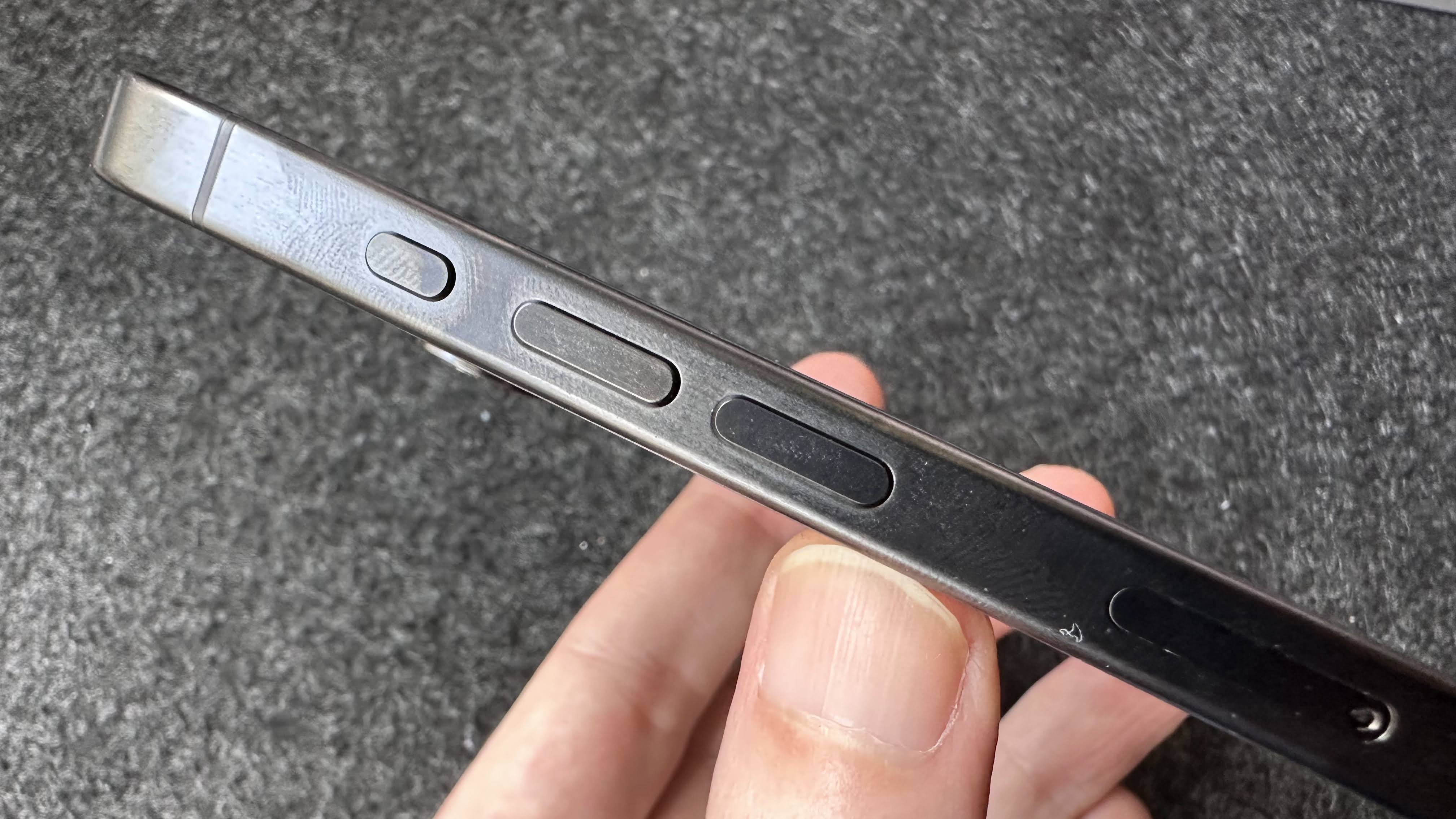
The use of titanium does allow for a couple of other useful changes though. While the OLED screen size remains unchanged at 6.1 inches (with a sharp 2556x1179 resolution and 2000 nit outdoor peak brightness), it feels more prominent thanks to slimmer bezels at its edge. Keeping that 120Hz refresh rate, it’s a gorgeous screen to use, responsive and naturally colorful. Dynamic Island (that reactive screen notch over the front-facing camera that shows contextual app data) has more apps than ever supporting it but hasn’t quite elevated above novelty in the year since its iPhone 14 Pro introduction.
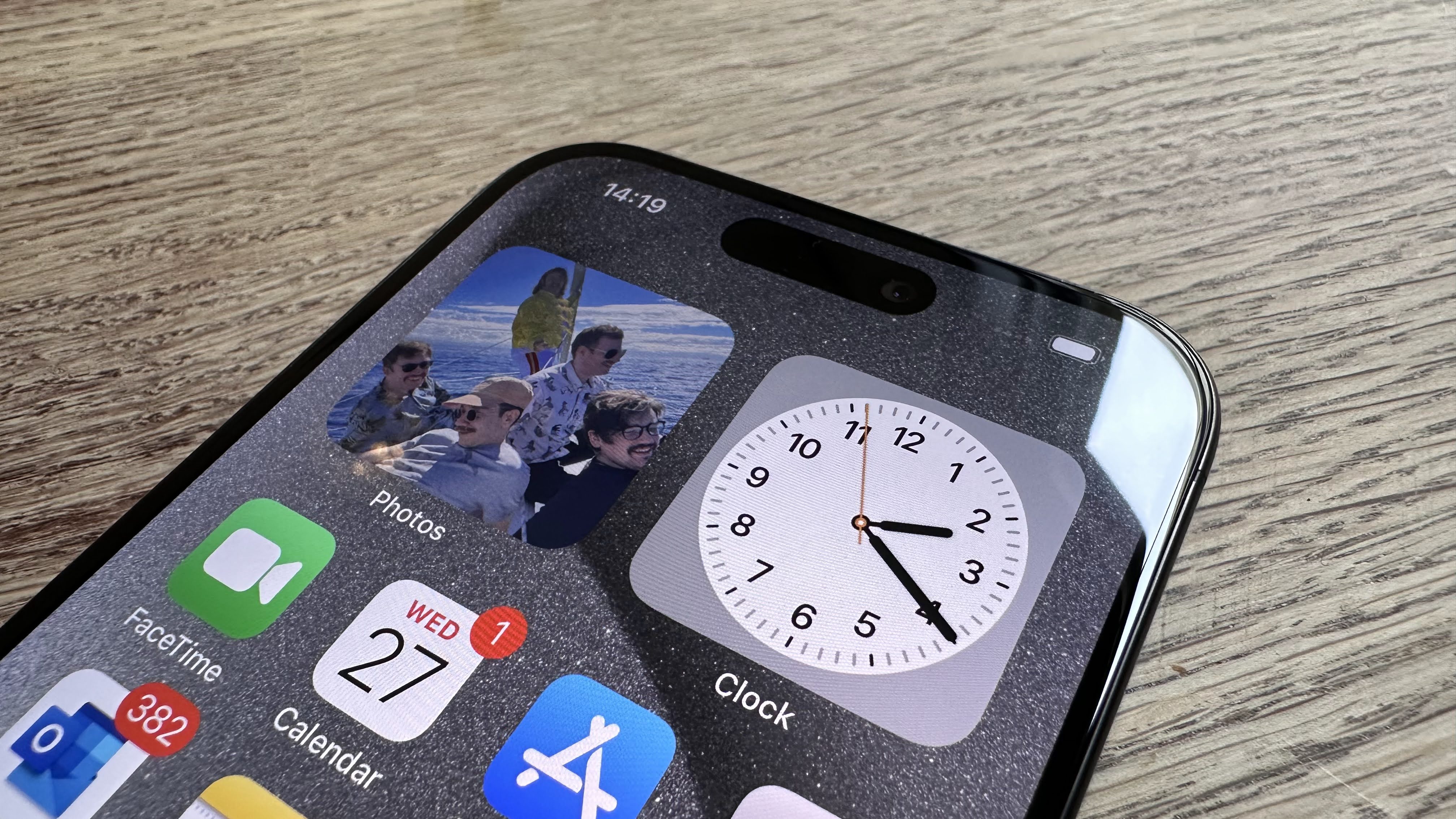
There’s a brutalist, industrial feel to the design.
Titanium also allows for a new, more easily repairable design. Like the iPhone 14 before it, the back glass is now removable as well as the front screen (behind which the internal components sit). It’s still not perfect as the experts at iFixit point out, and DIY repairs remain too difficult to recommend. But it’s a step in the right direction that should drive down the cost of many in-store repairs.
You get four colors to pick from with the iPhone 15 Pro, though they all feel like literal shades of gray, rolling through Black Titanium, White Titanium, Blue Titanium, and Natural Titanium. It’s the Black version you’ll see in this review. They’re not in-your-face colors, but I personally love them — there’s a brutalist, industrial feel to the design. MagSafe remains present for 15W wireless charging and magnetic case accessories and remains an unsung hero in the iPhone’s feature arsenal.

The first of two big additions to the exterior design of the phone is the Action Button. Cribbed from the Apple Watch Ultra and replacing the mute switch that’s been part of the iPhone since day one, it’s a great new tool.
Shortcuts turn the Action Button into the iPhone’s equivalent of a Swiss Army knife.
By default, it remains the Silent mode toggle, activated by a long press and accompanied by a haptic rumble. But you can also use it to switch on Focus mode, activate a specific camera mode and use it as a shutter button, turn on the Flashlight, record a Voice Memo, launch the Magnifier app or toggle an Accessibility feature. You can even set it to do nothing, though why you’d want it to do that is beyond me.
Shortcuts are where the Action Button comes into its own though. Apple’s macro-making toolbox can be configured to activate almost any function of any app with a bit of tinkering — even multiple app functions in sequence (say, turning on multiple HomeKit devices at once). It turns the Action Button into the iPhone’s equivalent of a Swiss Army knife, and I’m looking forward to seeing what crazy things Shortcuts enthusiasts map to it. There’s also a ‘Translate’ function set to land further down the line, though it’s not been implemented yet.
The Action Button is paired with a rather strange Settings selection menu option that shows the button while letting you scroll through an overlay of the above choices. It’s unlike any other part of the iPhone interface, and I wouldn’t be surprised if it becomes something a bit more prosaic in future generations once the novelty has worn off. A glimpse at a new interface language to come in the Apple Vision Pro, perhaps?

Oh, and did I mention that the iPhone 15 Pro has a USB-C port now? Unless you’ve been living under a rock, you’re probably aware of this significant change to this year’s iPhones. The ubiquitous reversible port sits on the bottom edge and tops out at USB 3.2 speeds of 10Gb/s with the right cable. I’ll go into more detail on the shift to USB-C later, but a quick note — there’s no improvement to fast charging speeds here, capped at 50% battery in 30 minutes with a 20W adapter or higher, even though USB-C is more than capable of delivering them.

As for connectivity, this year’s iPhone 15 Pro again features 5G cellular compatibility, with Wi-Fi getting a boost to the Wi-Fi 6E (802.11ax) standard for a faster, more stable connection using 6GHz bands, particularly when streaming. It’ll speed up device-to-device transfers between Wi-Fi 6E devices too (including the most recent MacBooks), so your AirDrop sends should be delivered much more quickly at double the speed. Bluetooth 5.3 is used for connecting wireless accessories, while a second-gen Ultra Wideband chip improves the accuracy of the Find My network. Thread radio networking is also supported — a sort of future-proofing nod to Matter’s possible smart home ascendancy. In the US, a new service with Roadside Assistance via satellite is coming to help with those frustrating-but-non-emergency travel mishaps, but wasn’t available for testing in the UK where this review was conducted.
iPhone 15 Pro Performance
iPhone 15 Pro makes use of the A17 Pro chip, which uses a 3nm process to squeeze in as many transistors as possible for faster performance. The 6-core CPU is 10 percent faster than the A16 Bionic (the chip found in iPhone 15, 15 Plus, and last year’s 14 Pro and 14 Pro Max), while a redesigned six-core GPU is up to 20 percent faster. Neural Engine improvements should make Machine Learning-focused use cases, such as image processing, up to twice as fast. RAM now reaches the heady heights of 8GB in this year’s Pro models, up from 6GB last year — though it's a feature Apple doesn’t disclose itself.
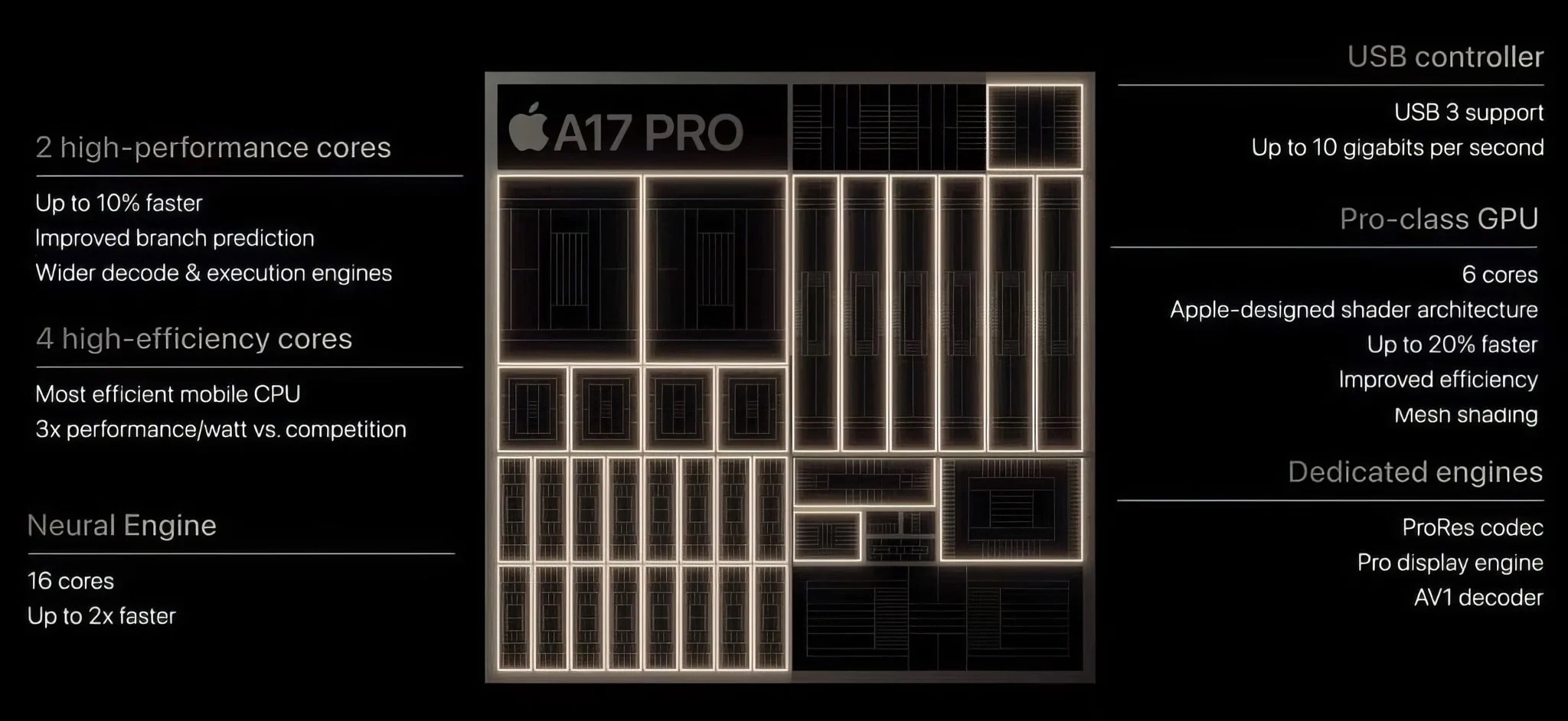
The iPhone 15 Pro is fast then — but so was the iPhone 14 Pro. In everyday use, unless you’re jumping from a significantly older device, you’re not going to feel much difference — apps continue to launch quickly, and swiping through the interface remains responsive. So where’s this extra oomph going to be best seen?
The real test of the A17 Pro chip’s performance is going to be a new wave of AAA gaming ports, set to land on the App Store in the coming months. Games like Capcom’s Resident Evil Village and Resident Evil 4 Remake, and Ubisoft’s upcoming Assassin’s Creed Mirage, are set to get native iPhone ports that take advantage of the A17 Pro chip. With advanced features like Ray Tracing and MetalFX upscaling that were previously only available on Mac, these won’t be watered-down ports, but versions at least comparable with their full-blown PS5 and Xbox Series X counterparts.
That’s impressive — crazy even. While we’ll reserve judgment until we’ve played them (there has to be some compromise somewhere, right?) it’s an ambitious leap. iPhone is already one of, if not the world’s most popular gaming platform, but it’s always associated with bubble-popping casual games, despite advancements like Apple Arcade. Can this latest push put the iPhone on a par with systems like the Switch? Here’s hoping.
iPhone 15 Pro Camera
More and more prominence is given to the iPhone’s place as the most-used camera in the world, and for good reason — it’s a darn good one. This year’s no different, with some significant improvements made to how you shoot, and the results you get.
There’s a lot to take in here, so where to start? Well first up, the 48MP camera now shoots at 24MP by default, whereas the 14 Pro defaulted at 12MP, resulting in a far more detailed image from the quad-pixel process pipeline. For pros looking to shoot at the full 48MP count, you can snap in HEIF and ProRAW formats for greater editing control later on.

A key new feature of the main camera is the ability to tap through different focal lengths. It starts at a native 24mm, and then up to more intimate 28mm and 35mm lens equivalents — common focal lengths used by pros, and available here at the same 24MP default as the 24mm. It’s essentially a form of digital zoom, but the processing of the resultant shots is so detailed as to blur the definitions. Combine that with the Ultra Wide camera’s 13mm focal length, its Macro mode (2cm minimum distance), the 48mm 2x telephoto zoom off the main sensor (again, a digital zoom), and the 77mm 3x zoom from the telephoto lens, and you’ve got plenty of shooting options. Take a look at the examples below, running through the different zoom and focal lengths:
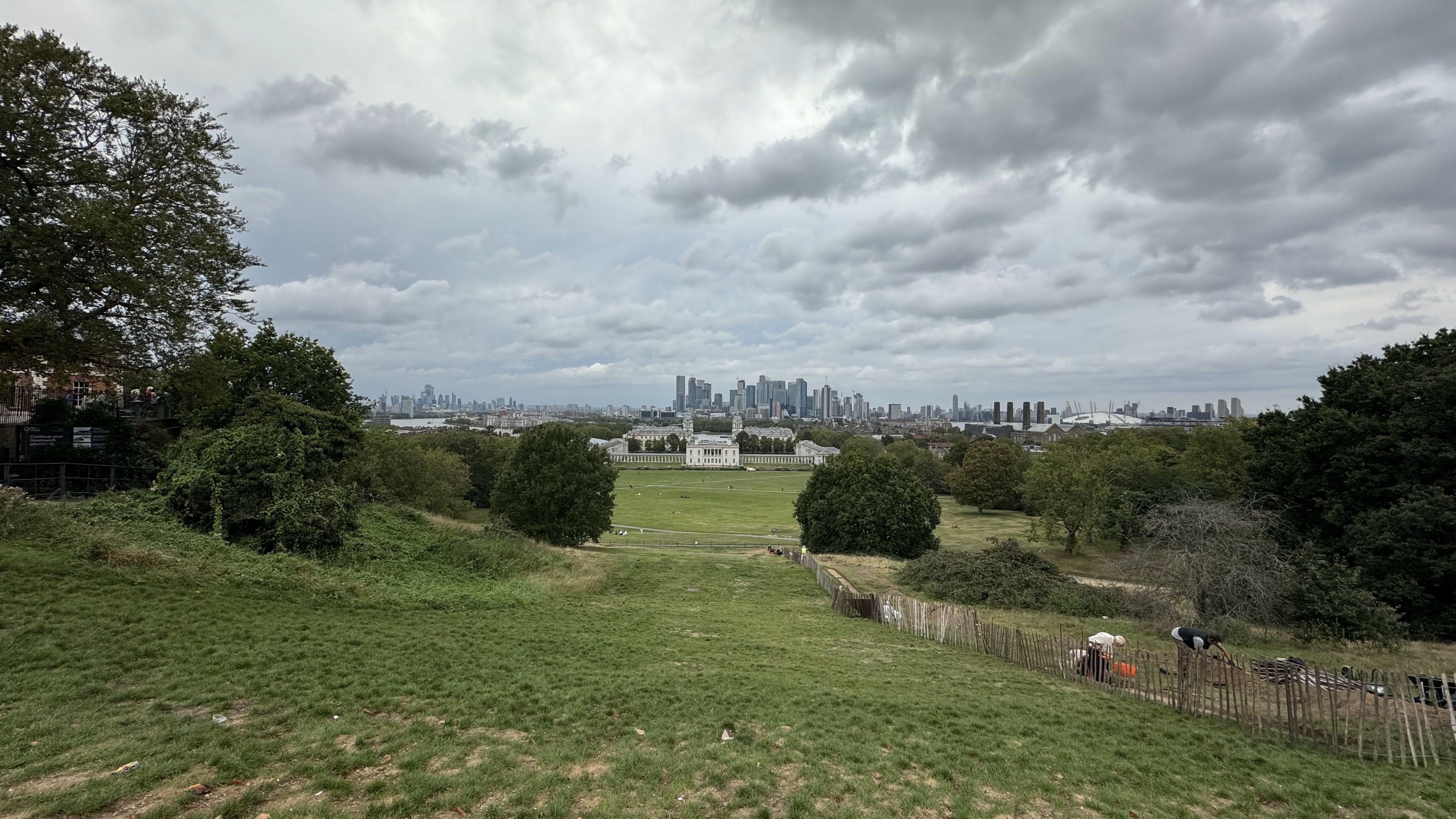

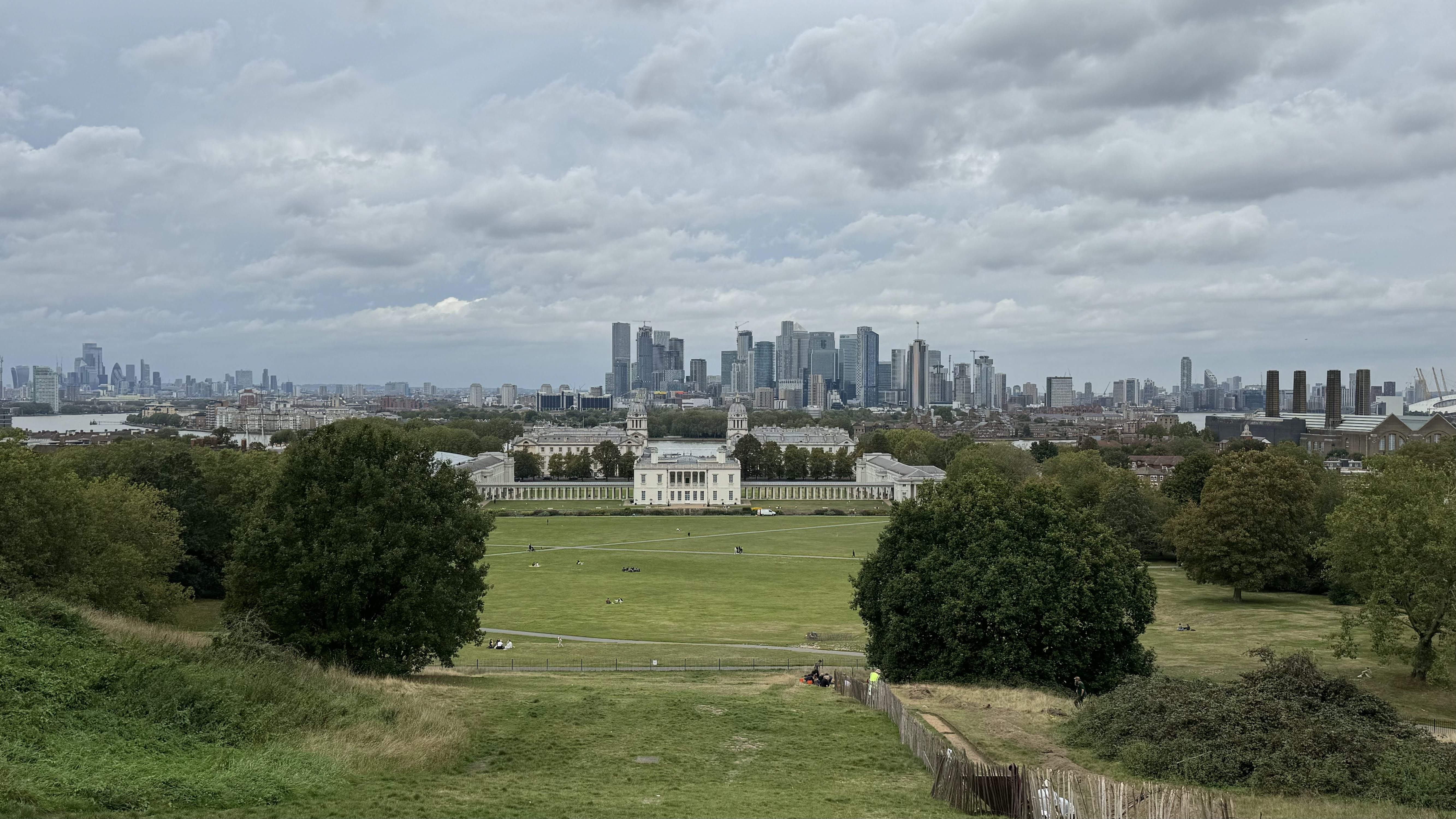

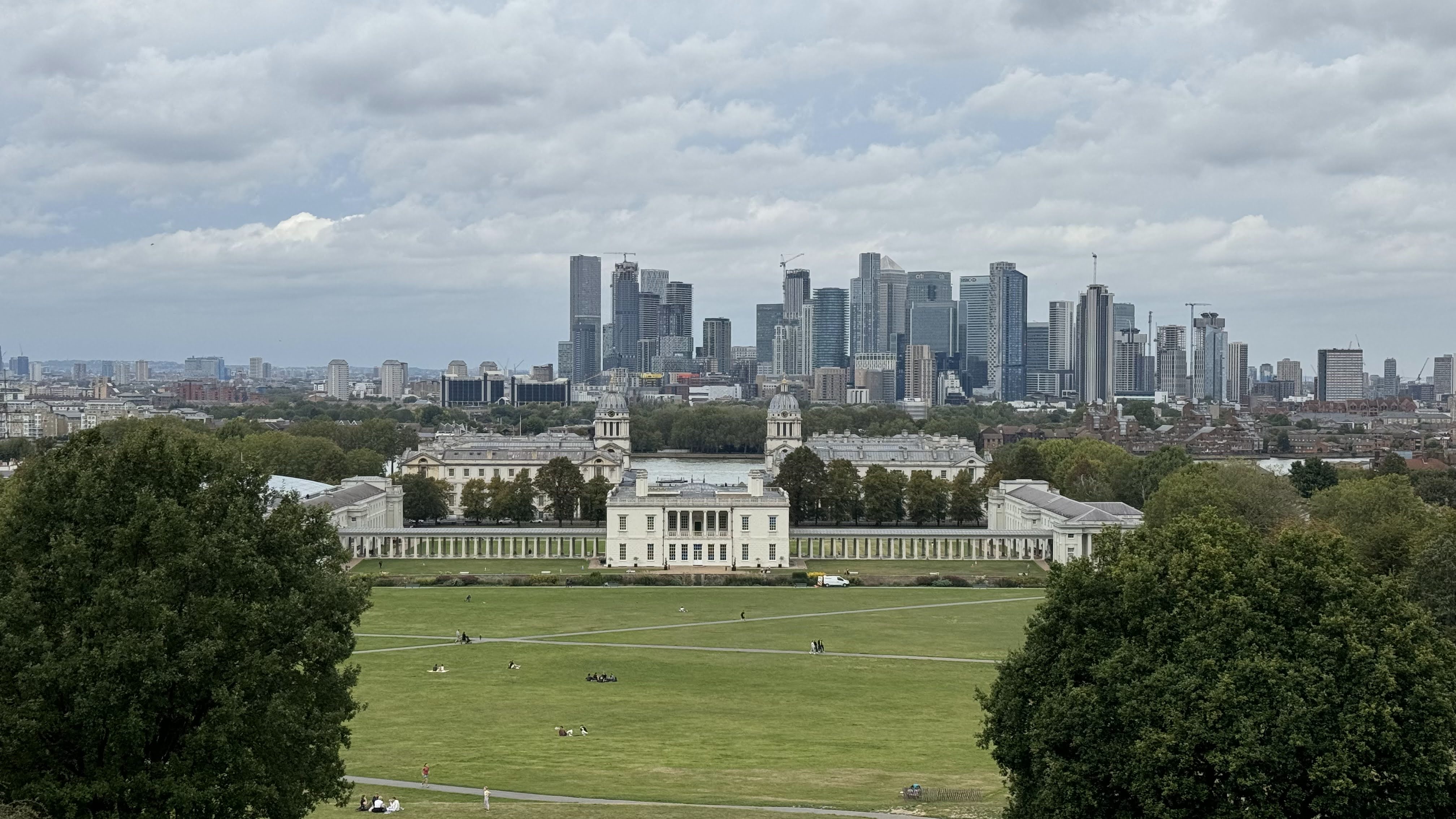

It’ll be interesting to see how far a future combination of the Photonic Engine and AI processing could refine camera zoom in the future.
The typical blazing sunshine of London on show in these shots! But the detail across the images is fantastic, with the iPhone 15 Pro’s Photonic Engine doing a fantastic job of retaining detail even from the digitally zoomed shots. Color and contrast on the ‘Standard’ natural setting are just that — true to the nature of the originally captured subject. It’s a processing style that I personally adore — where rivals can dial up the saturation, untouched iPhone 15 Pro captures feel more true to life to my eye. And that’s not to say they don’t pop — take a look at the cloud cover in the images above, and how the Smart HDR function pushes the brightness of the sun in the sky while retaining the tone and detail of the clouds. (Side note — the HDR API is now open to third-party apps, so you should see better-looking photos when shared through social platforms on iPhone too.)
Digital zoom still has its limits though. Maxing out at 15x on the device, this crop of the East London skyline shows smart processing in play, but unable to stop the sharp skyscraper lines from looking a bit wobbly in places. It’ll be interesting to see how far a future combination of the Photonic Engine and AI processing could refine this level of zoom in the future:

Portrait mode also gets some big changes and improvements. Live Photos are now supported in Portrait mode, adding a short video element alongside your shots. Photonic Engine is behind all Portrait shots now, but the coolest thing here is that provided the camera recognizes a face or pet (dogs or cats only) in the photo as it’s being captured, anything can be turned into a Portrait shot later when editing on-device. You’ll be able to dial in that bokeh blur even if it wasn’t captured in the initial intent — the iPhone retains a depth map to add that effect later on:
And that editing functionality extends to shots taken in Portrait mode on the front-facing selfie camera, too — say a shot with two faces, one in focus and one out, you could retroactively shift the focus to the other face. Take the examples below — two different images from the same shot, my face in focus in one, the tree behind me taking the focus in the other:
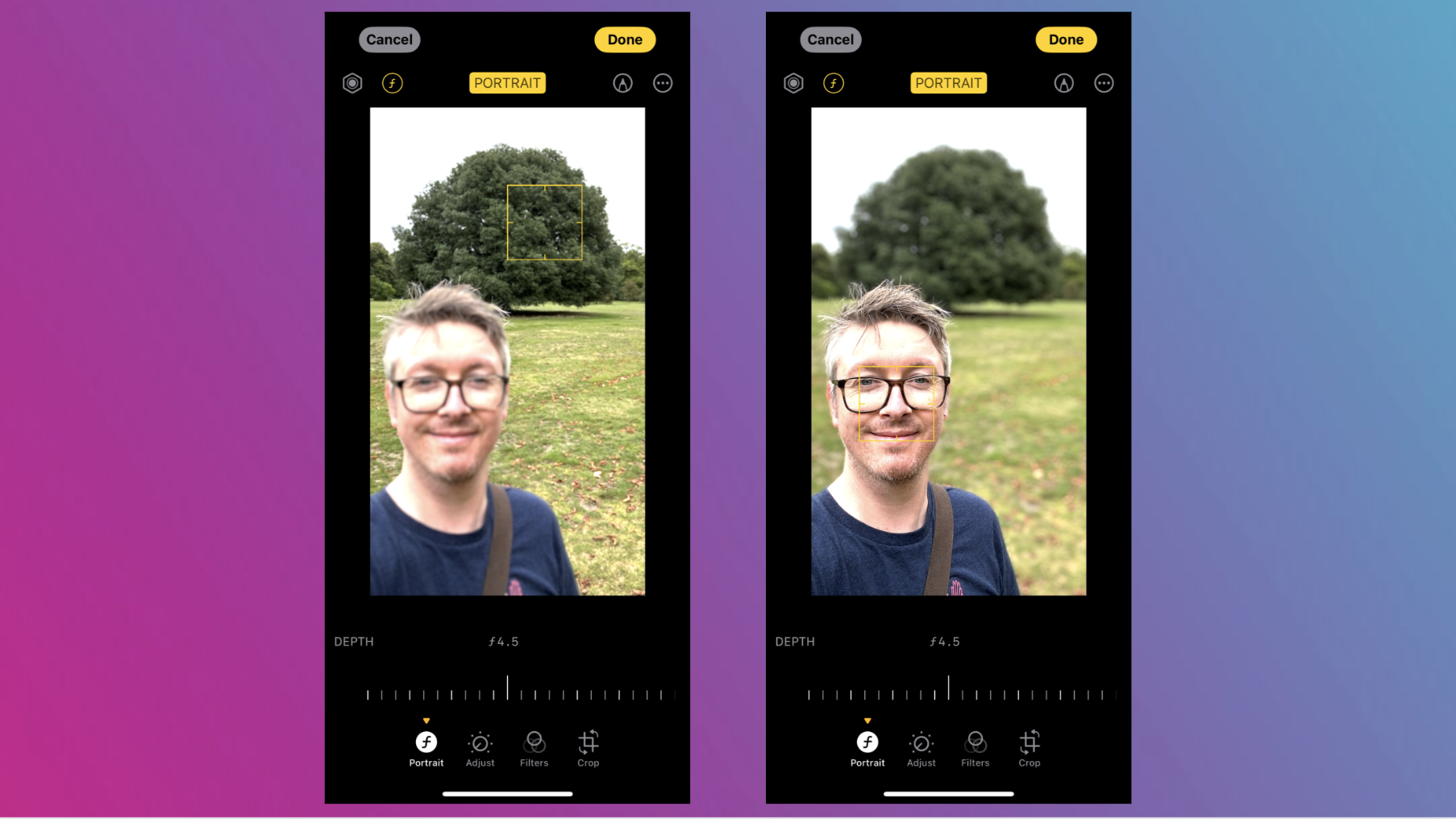
Macro mode continues to amaze and blows away the competition. Vibrantly colored, but with pin-sharp detail, it begs for close-ups to be taken. Look at the individual blobs of pollen on the stigma here:

Closing off still photography are improvements to low light photography. Photonic Engine can now pull even more detail and color from a poorly lit environment. Here’s a great example: London’s National Maritime Museum houses Turner’s grand painting of the Battle of Trafalgar, which has to be displayed away from bright natural light to preserve it. But the iPhone 15 Pro manages to pull out paint-flake details and all the subtlety and range of the artist's color palette:

Camera changes aren’t limited to still photography, with additions to video capture too. As with the Portrait mode, Cinematic mode now offers continuous digital zoom from 1x to 3x, and ProRes footage can now be captured with Log encoding. Along with new support for the industry-recognized Academy Encoding System (ACES), Log allows for easier professional color grading for projects shot on iPhone 15 Pro.
iPhone 15 Pro Battery and USB-C Features
It doesn’t take an EU regulator to tell you this, but the move to USB-C is great.
Apple’s quoting the same 23 hours of video playback for battery life off a single charge for the iPhone 15 Pro that it did for the iPhone 14 Pro, and in my experience of the two devices in day-to-day use, they’re certainly comparable. I can get through an entire day of what I’d consider relatively heavy use of the iPhone 15 Pro (calls, photography, video streaming, and app downloads, plus a ton of music playback and web browsing) without having to reach for a charger. Mileage will vary depending on the use case, but if you’re making an annual leap from iPhone 14 Pro to iPhone 15 Pro, expect to see little to no battery improvement, while those jumping from a 12 Pro, 13 Pro, or older will see at least a couple of hours extra juice available to them from a single charge — even with the Always On Display left active.
It doesn’t take an EU regulator to tell you this, but the move to USB-C is great. While there will certainly be users out there, happy with their reliable Lightning connections, who don’t see the big deal, anyone with even a passing interest in the wider world of tech gadgetry will rejoice.
It’s not just about charging convenience — though the likelihood is that almost every modern gadget you’ll have bought in the last five or so years will have been pushing USB-C, meaning you’ll have a plethora of backup cables waiting in the wings. It’s about the new tricks you’ll be able to pull with your iPhone as a result. I can charge other devices from the iPhone now — including the new USB-C AirPods Pro 2. I can get a wired Ethernet connection through my CalDigit Thunderbolt dock, while pulling files and photos off an SD card plugged into one of its ports. I can hook up real audiophile-grade headphones over that USB-C connection. So much is opened up by its inclusion, and I think the USB-C accessory market will see a huge boom in the coming months as a result.
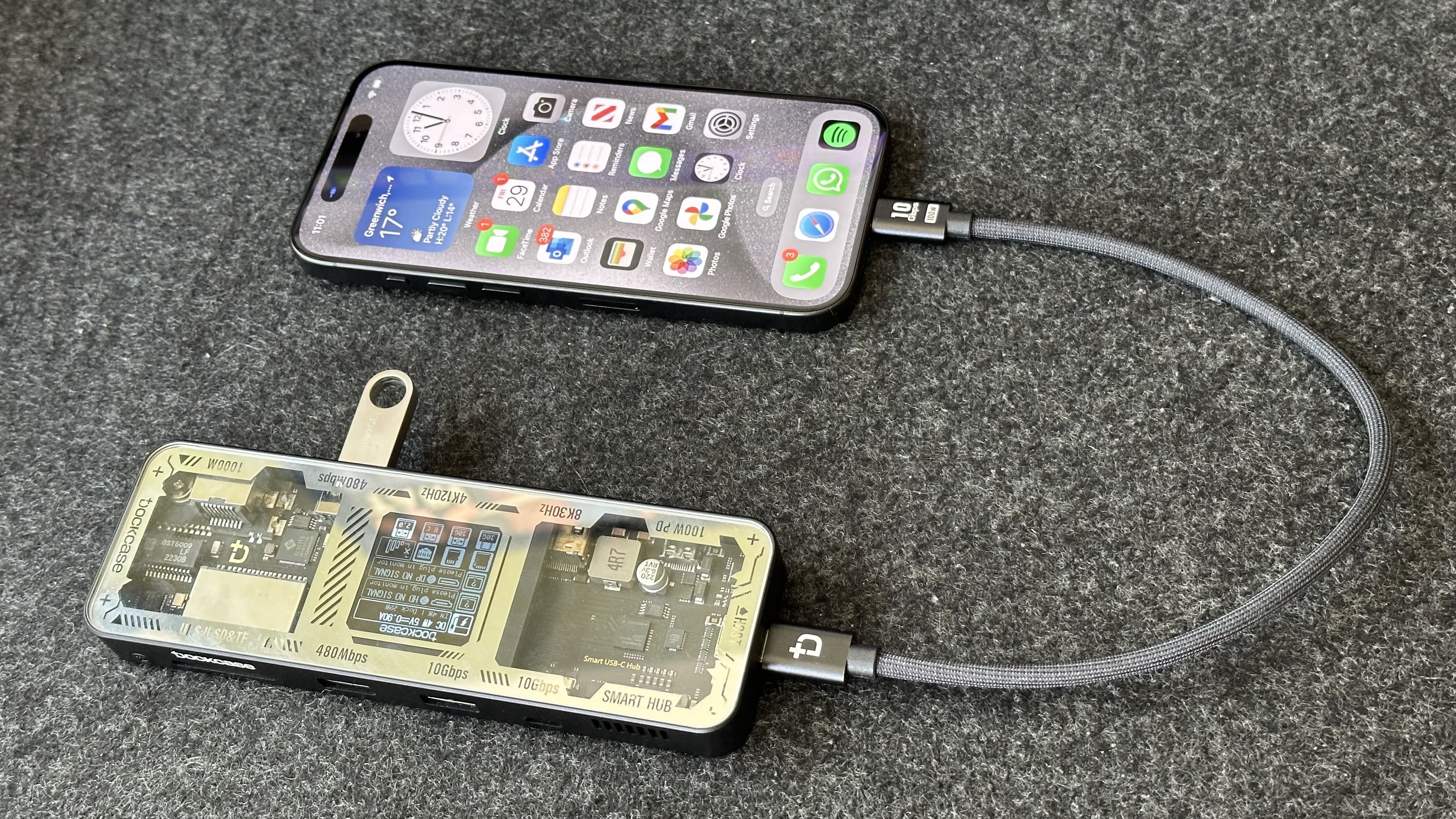
You can also use the port to record directly to external thumb and SSD drives. When you think of the file sizes of ProRAW images and ProRes videos, this is going to be a godsend for professional workflows that would need to keep running to a computer to offload content straight from the phone. Now you can just swap out a drive and keep on shooting. With a DisplayPort cable you can output 4K60fps Dolby Vision footage to an external monitor too, and considering ProRes now has Log encoding for color grading, iPhone 15 Pro is a more viable movie shooting option than ever before.
That’s before thinking of the army of USB-C accessories out there that I don’t have access to — Apple has been uncharacteristically open in basically letting the USB-C port be a USB-C port, with few if any notable exceptions.
Where Apple has cheaped out a bit is on the cable included in the box. The USB-C cable is merely of the USB 2 variety, despite the phone being USB 3.2 ready (with theoretical top transfer speeds of up to 10Gbps). So out of the box, you’re stuck with USB 2’s 480Mbps limit. These aren’t expensive cables to buy, so you’d assume they’re not expensive to make and throw in as standard.
iOS 17
iOS 17 comes as standard in the new iPhones and comes with some nice updates to the existing iPhone software feature set.
StandBy mode is probably the biggest addition. It turns your always-on smartphone into a smart display when left charging in landscape orientation. At-a-glance info like clocks, calendars, and widgets are customizable with the feature, as are photo slideshows, turning your phone into an Echo Show alternative, and potentially killing off your bedside alarm.
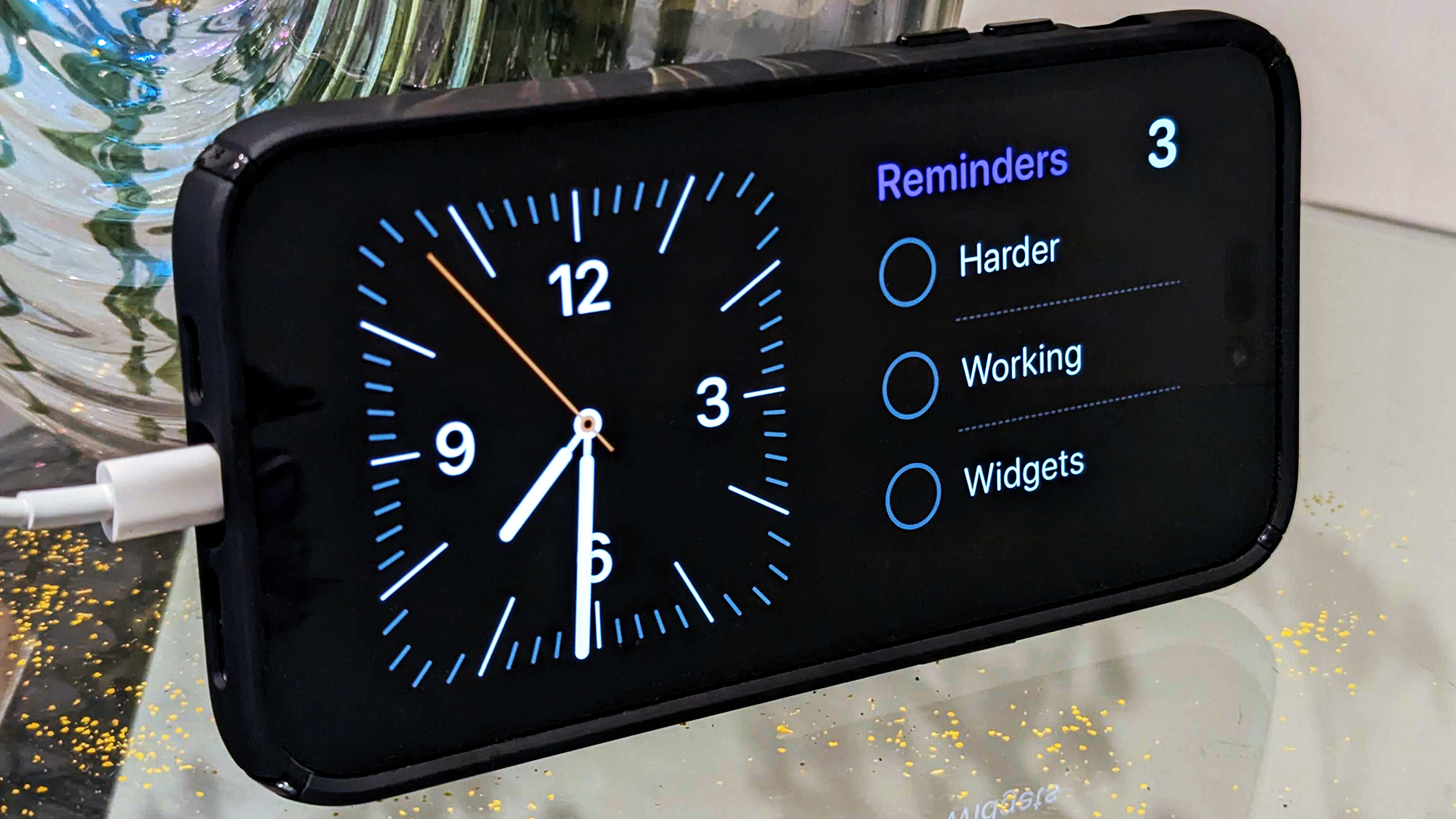
Contact Posters allow you to create a personalized contact card for anyone receiving calls from you, in an interface similar to iOS 16’s Homescreen customization options. You can share these using NameDrop, a new feature that uses NFC to top two iPhones together and instantly share contact information.
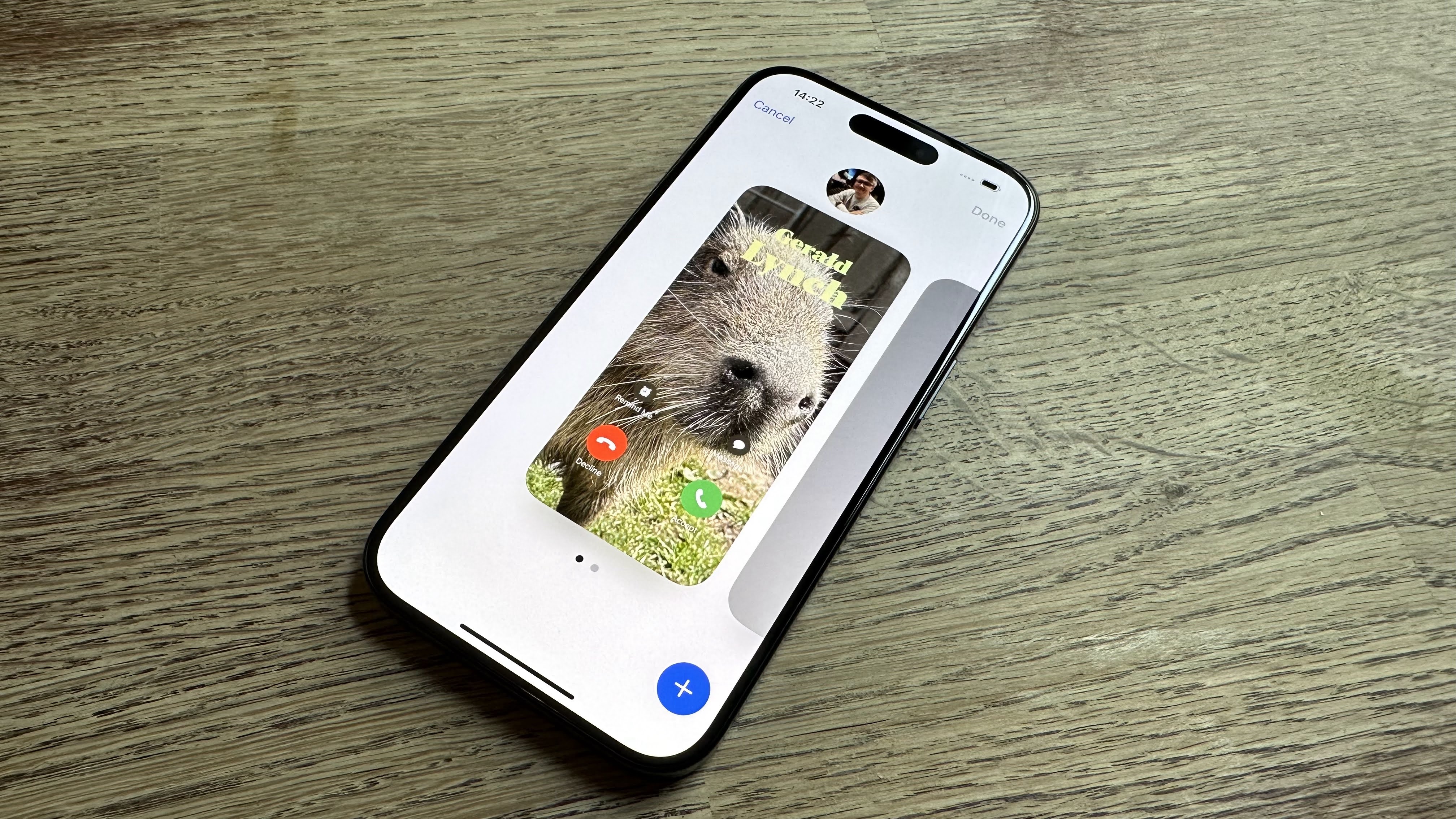
Messages can transcribe audio messages now and offers a Check In feature for keeping an eye on traveling friends. FaceTime now offers a video voicemail option and can work on Apple TV 4K using Continuity camera. Keyboard autocorrect uses a new language model for better ‘ducking’ spelling suggestions, as well as speeding up dictation. The last big addition is interactive widgets, letting you interact with their content from the Home Screen without needing to open up their associated app — it’s the sort of thing Android has done for years, but its eventual appearance is appreciated all the same.
It’s a solid progression for the operating system — read more in our full review below.
- Read more: iOS 17 review: top ten features ranked
And of course, the iPhone 15 Pro remains a great telephone, too. 5G support allows for consistent, speedy, and clear on-the-go connectivity, with the mics isolating voices for great call quality. The polish of Apple’s default apps, from Notes to Contacts to Photos to Calendar and beyond, remains of the highest standard, and integration with the iCloud cloud syncing and storage service makes for a seamless cross-device experience for those working on the same apps across macOS, iPadOS and watchOS.
How about the iPhone 15 Pro Max?
There’s more separation between the iPhone 15 Pro and the iPhone 15 Pro Max this year than we’ve seen in previous generations. Usually, it’s just screen size separating them, and it remains the key difference this year with their respective 6.1-inch and 6.7-inch displays. The iPhone 15 Pro Max starts at $200 more than the iPhone 15 Pro ($1,199 vs $999), but there are larger screens, slightly-differing storage capacity options, and a more complex camera system to account for that price difference. Remember that the iPhone 15 Pro Max now starts with 256GB storage as default this year, dropping the 128GB option entirely. So the price differential also reflects that the two Pro models start with different storage capacities.
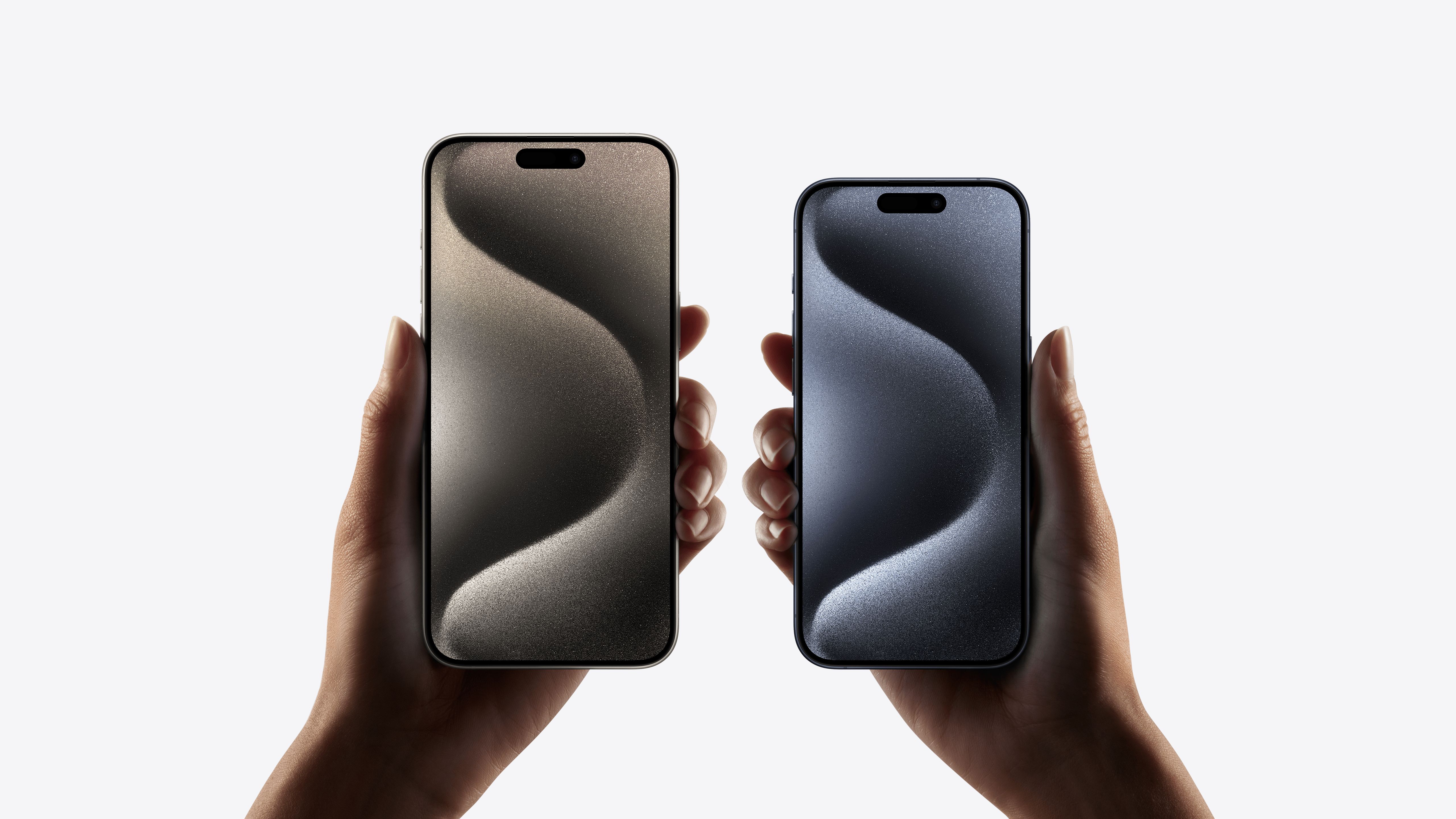
If it’s a choice between slipping something comfortably into my pocket 365 days a year, or taking advantage of 5x zoom a few times a year, I know which I’d prefer.
But there’s a key difference in the camera capabilities this year. Whereas the telephoto lens maxes out at 3x optical zoom on the iPhone 15 Pro, it pushes to a significantly zoomier 5x optical zoom on the iPhone 15 Pro Max. While 3x is great for portraiture, that headlining 5x zoom is dramatic, and useful for some of the most difficult-to-achieve photography situations you can imagine — think sharply capturing a distant animal subject on a safari, for instance. This is achieved with a cool tetraprism design, reflecting light rays four times, to achieve that level of zoom without dramatically increasing the size between the lens and sensor that’d result in a giant camera bump. To keep those shots steady at a higher zoom level, a newly minted combination of OIS and autofocus comes together in 3D sensor-shift module which makes minute physical movements as you focus on your subject up to 10,000 times per second, reducing blur and unwanted focus shifts.
Battery life is also notably better on the iPhone 15 Pro Max, with Apple quoting 29-hours between charges for the Pro Max compared to 23 hours on the Pro, when benchmarked against video playback. That’s most of a working day’s worth of extra life with the Pro Max this year.
- Read more: iPhone 15 Pro vs iPhone 15 Pro Max
Despite these definite benefits to the iPhone 15 Pro Max… I’m still drawn primarily to the iPhone 15 Pro. This is a machine that essentially never leaves your side, from morning to night. And though a bigger screen has day-long benefits, any device I rely on day in, day out, needs to be a bit more discreet in use. The size of the 15 Pro Max just negates that. Some people want a phone that makes them stand out from the crowd, and the 15 Pro Max will help in that pursuit. But if it’s a choice between slipping something comfortably into my pocket 365 days a year, or taking advantage of 5x zoom a few times a year, I know which I’d prefer.
Should you buy the iPhone 15 Pro?
Buy the iPhone 15 Pro if...
You're excited by the possibilities USB-C support opens up…
A long-awaited port change opens up a wealth of new workflow opportunities and accessories to the iPhone line, with more to come as the platform gets used to its new I/O.
… and the gaming potential of the A17 Pro chip
There’s not much to take advantage of the graphical capabilities of the A17 Pro chip today, but there’s a promising commitment to the high-end iPhones from AAA game developers to look forward to in the near future.
You use Shortcuts lots
The Action button is perfect for setting up quick-launch macro functions as created in the Shortcuts app. It’s like a magic button for any wild iPhone need you can think of.
You’re looking to upgrade from an iPhone 13 Pro or older handset
Two year’s worth of upgrades across the Pro range make for a significantly improved handset in the iPhone 15 Pro. There’s enough here to justify the leap to the 15 Pro’s price tag over the standard iPhone 15, too, even if the iPhone 15 is the best ‘standard’ iPhone Apple’s made in years.
Don’t buy the iPhone 15 Pro if...
You want the most advanced iPhone camera
For that, you’re going to need to splash the extra cash for the iPhone 15 Pro Max and its 5x optical zoom features. Though image quality from both will be remarkable.
You want a big ol’ screen
The iPhone 15 Pro Max is the way to go if you want the largest possible iOS device, though you’ll have to balance that against a loss in comfort and portability when holding it.
You’ve got an iPhone 14 Pro
There are solid improvements here over last year’s model, but not enough to justify an upgrade for anyone but the most die-hard enthusiasts.
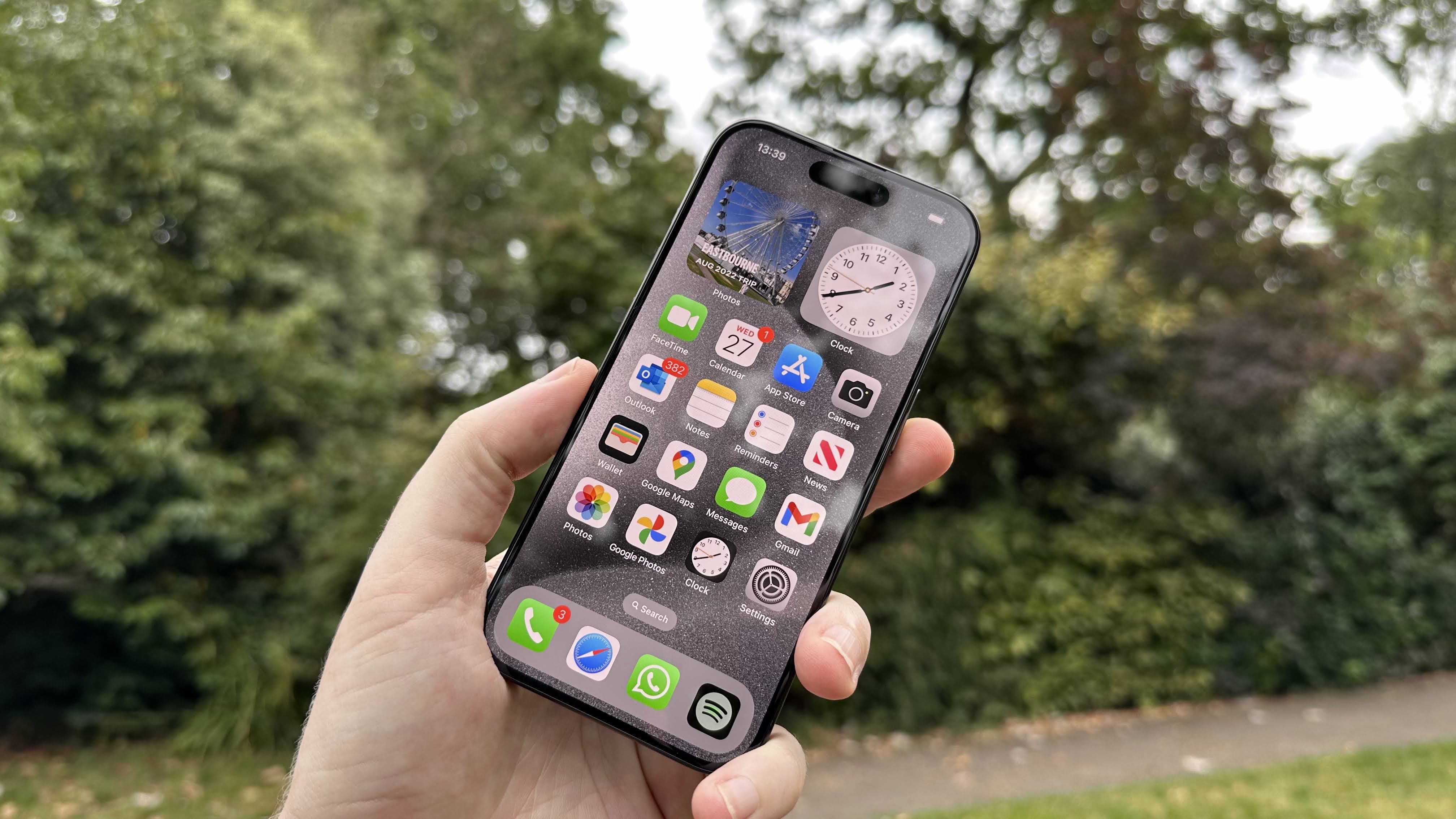
Verdict
The iPhone 15 Pro is a fantastic phone, packing cutting-edge camera tech, GPU power, and an excellent operating system into a compact, attractive, tough titanium body. We’re in the era of iterative upgrades with smartphones now, but Apple has again done just enough here to keep us excited.
The iPhone 15 Pro’s size makes it my device of choice over the iPhone 15 Pro Max.
USB-C is convenient and full of potential for accessory expansion — possibly even ready to interact with accessories already happily in your possession. A uniform and universal standard for data and charging, it’ll make working with the iPhone and the wider world of technology devices easier than ever. The Action Button is an excellent tool too, one that benefits from experimentation and play — it’s incredibly useful, once you’ve built a Shortcut with it to your most-used iPhone use cases (or even if you just turn it into an ‘auto-dial-Mom’ button).
The gaming potential here is through the roof — but until we see these big-ticket games launch, and other developers port AAA games to the iPhone, it remains potential untapped. Here-and-now benefits can be found in the camera improvements, with the Portrait mode performance leaps being one of the most compelling reasons for photographers to make the leap to iPhone 15 Pro.
The iPhone 15 Pro’s size makes it my device of choice over the iPhone 15 Pro Max, but the camera capabilities of the Pro Max sure are tempting this year. Hopefully, the discrepancy between the two is a short-lived one while Apple finds a way to squeeze the tetraprism into the smaller device, in time for the 16 Pro range. But my gut tells me that this extra degree of separation will remain as Apple looks to ‘upsell’ more customers to its most expensive devices.
The second best iPhone it may be, but the iPhone 15 Pro remains an impressive and worthy update to last year’s model and the one I’d recommend to almost everyone.
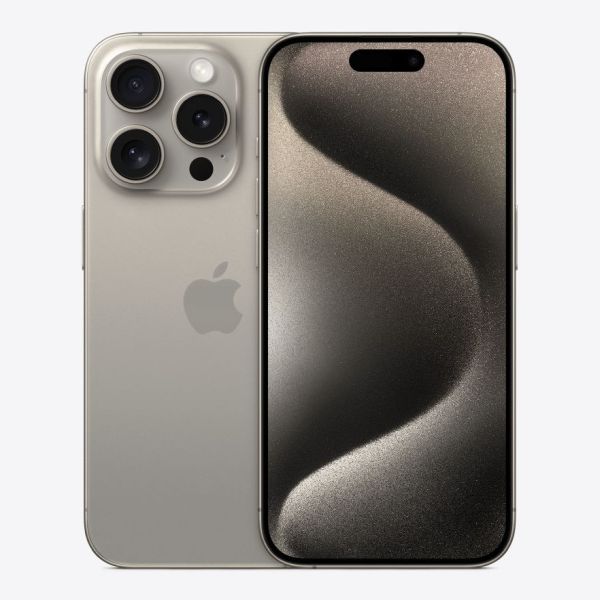
Bottom line: Apple's premium 'compact' iPhone for 2023, the iPhone 15 Pro makes impressive leaps in camera performance and GPU capabilities, while managing to knock a few grams off its overall weight too. USB-C and the Action Button are great additions to an already-refined package.

Gerald Lynch is the Editor-in-Chief of iMore, keeping careful watch over the site's editorial output and commercial campaigns, ensuring iMore delivers the in-depth, accurate and timely Apple content its readership deservedly expects. You'll never see him without his iPad Pro, and he loves gaming sessions with his buddies via Apple Arcade on his iPhone 15 Pro, but don't expect him to play with you at home unless your Apple TV is hooked up to a 4K HDR screen and a 7.1 surround system.
Living in London in the UK, Gerald was previously Editor of Gizmodo UK, and Executive Editor of TechRadar, and has covered international trade shows including Apple's WWDC, MWC, CES and IFA. If it has an acronym and an app, he's probably been there, on the front lines reporting on the latest tech innovations. Gerald is also a contributing tech pundit for BBC Radio and has written for various other publications, including T3 magazine, GamesRadar, Space.com, Real Homes, MacFormat, music bible DIY, Tech Digest, TopTenReviews, Mirror.co.uk, Brandish, Kotaku, Shiny Shiny and Lifehacker. Gerald is also the author of 'Get Technology: Upgrade Your Future', published by Aurum Press, and also holds a Guinness world record on Tetris. For real.
